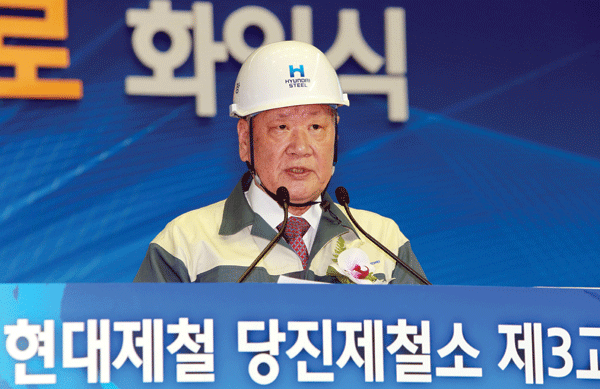STEEL
To usher an environment-friendly integrated steel mill era in KoreaChairman Chung Mong-koo fires 3rd
blast furnace at Dangjin Steel Mill
Hyundai Steel affiliated with the Hyundai Automotive Group, the world’s fifth-biggest carmaker by sales. lit its third blast furnace at its steel mill in Dangjin, 123 kilometers southwest of Seoul on Sept. 13, 2013 in a dedication ceremony attended by Chairman Chung Mong-koo and Marc Solvi, Chief Executive Officer of Paul Wurth S.A and other prominent guests and company officials.

Paul Wurth S.A was responsible for designs and supplies technological solutions for the third furnace blast. The company was founded in 1870 and is based in Luxembourg.
In his congratulatory message at the ceremony, the third blast furnace will usher in the era of environmental friendly integrated steel system in Korea for the first time and will eventually create 200,000 plus new job opportunities to inject fresh vigor into regional economy, among others.
Hyundai Steel has invested 9.89 trillion won ($9.1 billion) in the integrated steel mill over the past seven years to finish its “green field” investment project to build a 12-million-ton-a-year plant in Dangjin, Hyundai Steel is the country’s second-biggest steelmaker in terms of annual turnover after POSCO.
“Hyundai Steel will continue to make an investment to become a top-tier steelmaker, while sparing no efforts to create more job
Opportunities for young people to contribute to the local economy now suffering from protracted business slowdown,” Chairman Chung said

Thanks to the increased capacity from the Dangjin plant, Chairman Chung went on to say that Hyundai Steel is now in a position to supply half of the automotive steel consumed by Hyundai Motor and Kia Motors.
Hyundai Steel put two blast furnaces with a combined capacity of 8 million tons into operation in 2010 before the third blast furnace which was activated on Sept. 13.
Hyundai Steel plans to spend 1 trillion won to push forward a plan to build a plant to produce “ultra strength steel” used in core auto parts such as engines and transmissions but a timeframe for the plan is yet to be known.
Last year, the country imported 2.31 million tons of ultra strength steel, which is 30 percent of overall domestic consumption,
Currently, the steel company is responsible for about 40 percent of overall steel demand from the two car makers under the umbrella of Hyundai Group of companies.
In partnership with Hyundai Motor, Hyundai Steel has developed a total of 81 kinds of hot-rolled coil products used in vehicles in the past three years. The company said “it will put more focus on developing ultra-light, ultra-strong steel for future-concept cars.”
The spokesman said that globally, it is rare for an automotive group to have a steel-making affiliate which supplies steel products for the parent group. Korea has Hyundai Motor Group and Tata Group, which has Tata Motors and several steel mills under its wing, in India.

From the three smelting furnaces, Hyundai Steel is capable of producing 8.5 million tons of hot-rolled coil and 3.5 million thick steel plates used in making ships. Hot-rolled coil can be processed into cold-rolled coil which in turn is used to produce value-added products such as automotive steel.
Backed by higher local capacity, the country posted a trade surplus of $111 million in steel transactions in 2012, shifting from a trade deficit of $6.07 million in 2008, according to the Korea Iron & Steel Association (KOSA). Steel imports fell to 20.7 million tons in 2012 from 28.9 million tons in 2008, according to the statistics released by the government.
However, by import volume, Korea is still heavily dependent on steel products from Japan and China. It imported about 30 percent, or 20.71 million tons, out of the combined local capacity of 69.07 million tons.
The addition of the third blast furnace will help ease the country’s reliance on the neighboring countries.
Separately from the three blast furnaces, Hyundai Steel also runs 13 electric arc furnaces whose capacity reaches 12 million tons. Electric arc furnaces produce steel using scrapped steel while blast furnaces make steel using iron oil and coking coal. k

